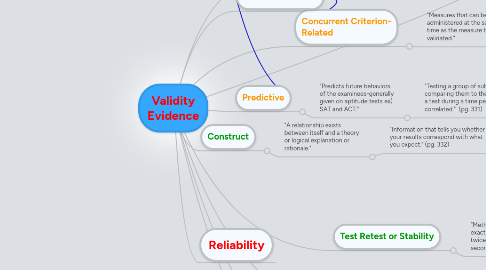Validity Evidence
by brad jansen


1. Reference: Kubiszyn, T. & Borich, G. (2010). Correlation. 9th Ed. Educational Testing & Measurement: Classroom Application and Practice (pp. 317-328). Hoboken, NJ: Wiley.
2. Kuder Richardson
2.1. “Measure the extent to which items within one form of the test have as much in common with one another as do the items in that one form with one form with corresponding items with equivalent form” (pg. 344)
3. Split Half
3.1. “Each item in the test is assigned to one half or the other, then the total score for each student on each half is determined and the correlation is computed” (pg. 343)
4. Internal Consistency
4.1. “The items should be correlated with each other, and the test should be estimated by internal consistency” (pg. 343 )
5. Test Retest or Stability
5.1. “Method of Estimating reliability that is exactly what its name implies, A test given twice and correlation between the first and second set of scores.” (pg. 341)
6. Concurrent Criterion- Related
6.1. "Measures that can be administered at the same time as the measure to be validated."
6.1.1. "Provides a numerical value which takes a new test and correlates it to an old test group." (pg. 330)
7. Content
7.1. "Inspecting a test to see if questions are corresponding to what the user decides should be covered."
7.1.1. Do we match our educational objectives and standards? (pg. 330)
8. Criterion- Related
9. Predictive
9.1. "Predicts future behaviors of the examinees-generally given on aptitude tests ex) SAT and ACT."
9.1.1. "Testing a group of subjects, then comparing them to the prediction of a test during a time period and then correlated." (pg. 331)
10. Construct
10.1. "A relationship exists between itself and a theory or logical explanation or rationale."
10.1.1. "Information that tells you whether your results correspond with what you expect." (pg. 332)
